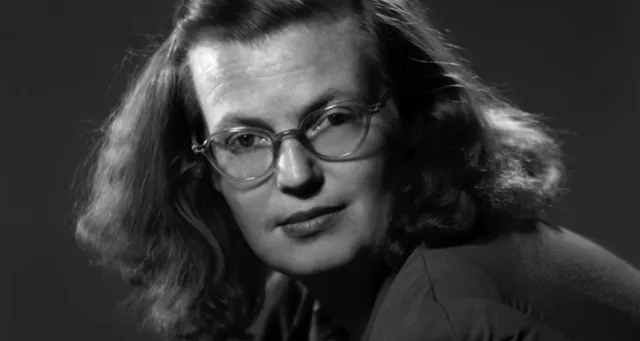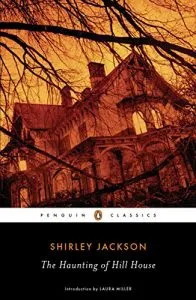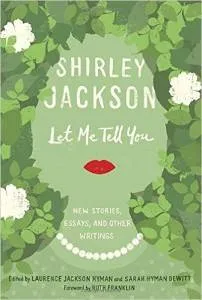
Your Complete Guide to Shirley Jackson Books and Stories
This content contains affiliate links. When you buy through these links, we may earn an affiliate commission.
For years best known as the author of the creepy (and often assigned in high school and/or college English classes) short story “The Lottery,” Shirley Jackson and her many other works have been gaining recognition and popularity in recent years. If you’re wondering where to start with Shirley Jackson books and short stories, look no further!
 Shirley Jackson: A Rather Haunted Life by Ruth Franklin
This biography is comprehensive and detailed, and feels like a conversation with Ruth Franklin, perhaps over a glass of bourbon and a pack of Pall Malls (Shirley’s preferred drink and cigarette brand). I cannot recommend it highly enough.
(Please note that I do not recommend reading her earlier biography by Judith Oppenheimer, as it is my opinion that one should not write a biography of someone they clearly dislike.)
Although Ruth Franklin’s TinyLetter is no longer strictly about Shirley Jackson, as it was leading up to the release of A Rather Haunted Life, you can catch up on the archives at the link above. This is a wonderful and electrifying place to start: the letters in the barn.
I briefly discussed Shirley and Stanley’s marriage (among others) in The Lives of Literary Wives.
It was announced on August 30 that a book of Shirley’s letters is forthcoming from Random House.
Shirley Jackson: A Rather Haunted Life by Ruth Franklin
This biography is comprehensive and detailed, and feels like a conversation with Ruth Franklin, perhaps over a glass of bourbon and a pack of Pall Malls (Shirley’s preferred drink and cigarette brand). I cannot recommend it highly enough.
(Please note that I do not recommend reading her earlier biography by Judith Oppenheimer, as it is my opinion that one should not write a biography of someone they clearly dislike.)
Although Ruth Franklin’s TinyLetter is no longer strictly about Shirley Jackson, as it was leading up to the release of A Rather Haunted Life, you can catch up on the archives at the link above. This is a wonderful and electrifying place to start: the letters in the barn.
I briefly discussed Shirley and Stanley’s marriage (among others) in The Lives of Literary Wives.
It was announced on August 30 that a book of Shirley’s letters is forthcoming from Random House.
This novella packs a punch into a slim 214 pages (in my paperback copy). It showcases Ms. Jackson’s stunning ability to craft a perfect sentence, and then do it again, and again, and again, and keep doing it until the end of the book.
Merricat Blackwood has lived in near-total isolation with her sister Constance and their ailing uncle Julian since the rest of their family died. One day their cousin Charles shows up, looking for the family fortune he is certain the sisters are hiding.
I also saw the film adaptation of We Have Always Lived in the Castle (and I loved it). If you’re in the U.S., you can catch it on Netflix.
(Note: whatever you do, and no matter how tempted you may be, do not read the stage adaptation by Hugh Wheeler, in which the character of Jonas the cat is reimagined as “a colored boy of nine years.” Because it was the 1960s, the cast list notes that a white boy may be cast instead. Barf.)
There isn’t a more classic Shirley Jackson book than The Haunting of Hill House, nor is there a more classic horror novel than The Haunting of Hill House. There isn’t a book that has ever scared me as much as The Haunting of Hill House.
Psychiatrist and occult scholar Dr. Montague invites people who have experienced psychic phenomena to stay in a house that is believed to be haunted and either disprove or (hopefully) prove the rumors. Eleanor, Theo, Luke (the heir to Hill House), and Dr. Montague meet at Hill House. Things happen. Eleanor is not okay. Can a house be evil?
A Viewing Guide to Adaptations of The Haunting of Hill House
Did you know Shirley also wrote wholesome, lighthearted, comedic family stories? OH YES SHE DID. These stories, primarily about her children and household, paid the bills. Originally published individually in women’s magazines, the stories were collected and woven together into the loose, largely fictionalized memoirs Life Among the Savages and Raising Demons. These books are warm, funny, and magical. They describe a life that is both hectic and #goals. They are also responsible for my absolute conviction that I wanted four children (I have two and am very done).
Emma Nichols also gives the rundown on these books in Shirley Jackson and the Mundane Horrors of Motherhood.
If you read the stories in Dark Tales and love them, which you will, I would advise moving on to The Lottery and Other Stories, the only collection published during Shirley’s lifetime. While I believe her abilities grew tremendously from this book, as showcased in Dark Tales, this is a wonderful collection.
Note: It is also worth picking up the graphic novel adaptation of the story The Lottery as it is illustrated by Shirley’s grandson, Miles Hyman, and shows an interesting alternate way to tell the story.
Lastly, you must pick up Let Me Tell You, the stunning volume released in 2015 to commemorate the 50th anniversary of her death. Lawrence and Sarah went back to the archives, diving into several previously unmined boxes of papers and selecting previously unseen stories. (A confession: I have not read every story in this collection yet, because I am afraid it will be the very last one. I never dreamed there would be another after Just An Ordinary Day, and I don’t want there to never be another Shirley Jackson story to read.)
Who Was Shirley Jackson?
Born December 14, 1916, in Burlingame, California, Shirley Jackson was one of the great American novelists of the 20th century. Her family moved to Rochester, New York, in the early 1930s. After finishing high school and completing a year at the University of Rochester, she transferred to Syracuse University, where she met her husband, the literary critic Stanley Hyman. After a few years in New York, they moved to Vermont, where they lived (except for a brief move to Connecticut) for the rest of their lives. She died of heart failure on August 8, 1965, at age 48, in her home in North Bennington, Vermont, and was survived by her husband and their four children. Her archives are maintained by the Library of Congress, and two of her children, Laurence Jackson Hyman and Sarah Hyman DeWitt, have continued to posthumously publish stories they have found in those archives. In her lifetime, Shirley Jackson published six novels, two memoirs, a nonfiction book for young people, a children’s play, a picture book, and a collection of short stories, in addition to many individual stories in various magazines. She was working on a seventh novel at the time of her death, and it was published posthumously, incomplete, with more stories. Additional collections have been published since. Her work has been adapted into stage plays, graphic novels, movies, television, and more. Although several of her works have gone out of print over the years, nearly her entire oeuvre is currently available thanks to the resurgence in interest in her genius.Further Reading And Shirley Jackson Biographies
 Shirley Jackson: A Rather Haunted Life by Ruth Franklin
This biography is comprehensive and detailed, and feels like a conversation with Ruth Franklin, perhaps over a glass of bourbon and a pack of Pall Malls (Shirley’s preferred drink and cigarette brand). I cannot recommend it highly enough.
(Please note that I do not recommend reading her earlier biography by Judith Oppenheimer, as it is my opinion that one should not write a biography of someone they clearly dislike.)
Although Ruth Franklin’s TinyLetter is no longer strictly about Shirley Jackson, as it was leading up to the release of A Rather Haunted Life, you can catch up on the archives at the link above. This is a wonderful and electrifying place to start: the letters in the barn.
I briefly discussed Shirley and Stanley’s marriage (among others) in The Lives of Literary Wives.
It was announced on August 30 that a book of Shirley’s letters is forthcoming from Random House.
Shirley Jackson: A Rather Haunted Life by Ruth Franklin
This biography is comprehensive and detailed, and feels like a conversation with Ruth Franklin, perhaps over a glass of bourbon and a pack of Pall Malls (Shirley’s preferred drink and cigarette brand). I cannot recommend it highly enough.
(Please note that I do not recommend reading her earlier biography by Judith Oppenheimer, as it is my opinion that one should not write a biography of someone they clearly dislike.)
Although Ruth Franklin’s TinyLetter is no longer strictly about Shirley Jackson, as it was leading up to the release of A Rather Haunted Life, you can catch up on the archives at the link above. This is a wonderful and electrifying place to start: the letters in the barn.
I briefly discussed Shirley and Stanley’s marriage (among others) in The Lives of Literary Wives.
It was announced on August 30 that a book of Shirley’s letters is forthcoming from Random House.
Where to Begin with Shirley Jackson Books
This is largely a matter of taste, and I won’t pretend that I think you should do anything other than read every word she ever wrote. However, I can suggest a sort of reading order. If You Want to be Wowed, Start With We Have Always Lived in the Castle.
If You Want to be Wowed, Start With We Have Always Lived in the Castle.
This novella packs a punch into a slim 214 pages (in my paperback copy). It showcases Ms. Jackson’s stunning ability to craft a perfect sentence, and then do it again, and again, and again, and keep doing it until the end of the book.
Merricat Blackwood has lived in near-total isolation with her sister Constance and their ailing uncle Julian since the rest of their family died. One day their cousin Charles shows up, looking for the family fortune he is certain the sisters are hiding.
I also saw the film adaptation of We Have Always Lived in the Castle (and I loved it). If you’re in the U.S., you can catch it on Netflix.
(Note: whatever you do, and no matter how tempted you may be, do not read the stage adaptation by Hugh Wheeler, in which the character of Jonas the cat is reimagined as “a colored boy of nine years.” Because it was the 1960s, the cast list notes that a white boy may be cast instead. Barf.)
 If You Want to be Scared, Read The Haunting of Hill House.
If You Want to be Scared, Read The Haunting of Hill House.
There isn’t a more classic Shirley Jackson book than The Haunting of Hill House, nor is there a more classic horror novel than The Haunting of Hill House. There isn’t a book that has ever scared me as much as The Haunting of Hill House.
Psychiatrist and occult scholar Dr. Montague invites people who have experienced psychic phenomena to stay in a house that is believed to be haunted and either disprove or (hopefully) prove the rumors. Eleanor, Theo, Luke (the heir to Hill House), and Dr. Montague meet at Hill House. Things happen. Eleanor is not okay. Can a house be evil?
A Viewing Guide to Adaptations of The Haunting of Hill House
- The Haunting, d. Robert Wise, 1963—This movie is spectacular and a must-watch. It is a good adaptation of the source material, while limited by various factors. In my opinion, the final lines improve on the book.
- The Haunting, d. Jan de Bont, 1999—No, nope, pass, do not bother unless you want to get sauced and have a laugh. (And even then, probably don’t. I warned you.)
- The Haunting of Hill House, Netflix, 2018—this series is loosely based on the setting of the book and borrows character names but invents a wholly new plot. While I have no use for it, it has been wildly successful and many people love it. Rioter Alex Luppens-Dale wrote about the references to the novel in the series.




 The Lottery And Other Stories
The Lottery And Other Stories Let Me Tell You
Let Me Tell You

